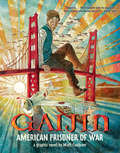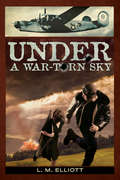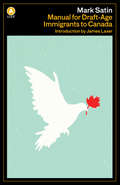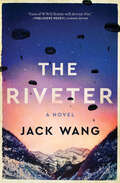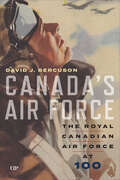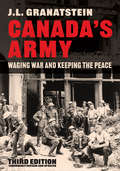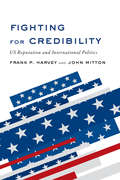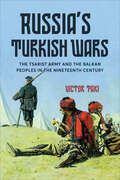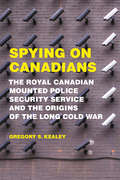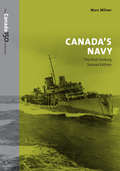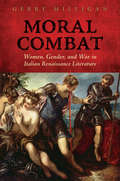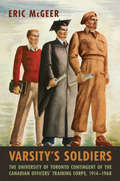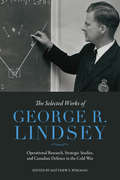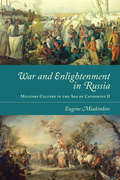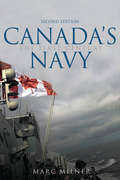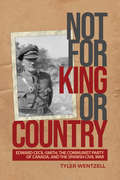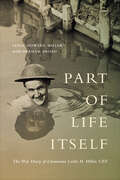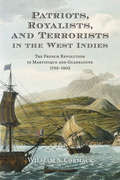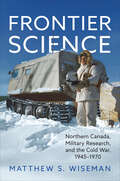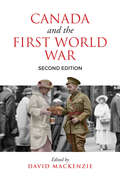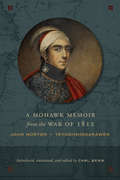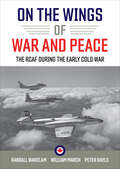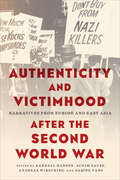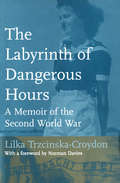- Table View
- List View
Gaijin: American Prisoner of War
by Matt FaulknerWith a white mother and a Japanese father, Koji Miyamoto quickly realizes that his home in San Francisco is no longer a welcoming one after Pearl Harbor is attacked. And once he's sent to an internment camp, he learns that being half white at the camp is just as difficult as being half Japanese on the streets of an American city during WWII. Koji's story, based on true events, is brought to life by Matt Faulkner's cinematic illustrations that reveal Koji struggling to find his place in a tumultuous world-one where he is a prisoner of war in his own country.
Under a War-Torn Sky (Under A War-torn Sky Ser. #2)
by L.M. ElliottWounded and alone behind enemy lines, a young pilot must find his way to freedom in this gripping, beloved novel When Henry Forester is shot down during a bombing run over France, the World War II pilot finds himself trapped behind enemy lines. In constant danger of discovery by German soldiers, Henry begins a remarkable journey to freedom. Relying on the kindness of strangers, Henry moves from town to town--traveling by moonlight, never asking questions, or even the names of the people who help him along the way. Each day brings him closer to home, yet every step in enemy territory invites new dangers.Even as Henry fights for his own life, he quickly grows to realize the peril that surrounds all of the French people, and to admire the courage of the freedom fighters who risk death to protect him. Suspenseful and achingly true, this critically-acclaimed and deeply beloved novel explores the heartbreak of war, the strength of human spirit, and one young man's struggle to protect the things he loves.
Manual for Draft-Age Immigrants to Canada
by Mark SatinIn print for the first time since 1971, Manual for Draft-Age Immigrants to Canada has once again become relevant in a time of major political upheaval in the United States of America.First published in 1968 by House of Anansi Press, the Manual for Draft-Age Immigrants to Canada was a handbook for Americans who refused to serve as draftees in the Vietnam War and were considering immigrating to Canada. Conceived as a practical guide with information on the process, the Manual also features information on aspects of Canadian society, touching on topics like history, politics, culture, geography and climate, jobs, housing, and universities.The Manual went through several editions from 1968–71. Today, as Americans are taking up the discussion of immigration to Canada once again, it is an invaluable record of a moment in our recent history.
The Riveter: A Novel
by Jack WangA cross-cultural love story set against the dramatic backdrop of the Allied invasion of Europe in WWII. Vancouver, 1942. Josiah Chang arrives in the bustling city ready to serve his country in the war against fascism, but Chinese Canadians are barred from joining the army out of fear they might expect citizenship in return. So, Josiah heads to the shipyard to find work as a riveter, fastening together the ribs and steel plates of Victory ships. One night, Josiah spots Poppy singing at a navy club. Despite their different backgrounds, they fall for each other instantly and begin a starry-eyed romance that lasts until the harsh reality of their situation is made clear. Determined to prove himself, Josiah takes a train to Toronto where he’s finally given the chance to enlist. After volunteering for the 1st Canadian Parachute Battalion and jumping into Normandy on D-Day, he must fight through the battlefields of Europe to make it back to the woman he loves. By turns harrowing and exhilarating, The Riveter explores what one man must sacrifice to belong to the only country he has ever called home.
Canada’s Air Force: The Royal Canadian Air Force at 100
by David BercusonThe Royal Canadian Air Force (RCAF) was founded in 1924 as a sort of federal air service, carrying out civilian-type operations for Ottawa. In the Second World War, the RCAF grew to more than 200,000 personnel in overseas squadrons and performed virtually every type of mission, including bombing and hunting submarines. Over the decades since, the RCAF has tried valiantly to carry out its mission of defending Canada, even when starved of funds by the federal government. Today, it is once again on the verge of becoming a modern, well-equipped air force. In Canada’s Air Force, historian David J. Bercuson shares the history of the first one hundred years of the Royal Canadian Air Force, from its inception in 1924 to its centennial in 2024. Drawing on memoirs, diaries, unpublished histories, archival sources, interview transcripts, and standard reference works such as The Bomber Command War Diaries, Bercuson traces the history of the RCAF as not only a fighting force but also a human institution. Canada’s Air Force analyses the first century of the RCAF through the clear-eyed perspective of a Canadian historian who has closely scrutinized one hundred years of the RCAF’s story.
Canada's Army: Waging War and Keeping the Peace, Third Edition
by J.L. GranatsteinWritten by J.L. Granatstein, one of the country's leading political and military historians, Canada's Army traces the full three-hundred-year history of the Canadian military. This thoroughly revised third edition brings Granatstein’s work up to date with fresh material and new scholarship on the evolving role of the military in Canadian society. It includes new coverage of the War in Afghanistan; NATO deployments to Poland, Latvia, and Iraq; aid to the civil power deployments; and the role of the army reserve. Masterfully written and passionately argued, Canada's Army offers a rich analysis of the political context for the battles and events that shape our understanding of the Canadian military.
The First World Oil War
by Timothy C. Winegard Sir Hew StrachanOil is the source of wealth and economic opportunity. Oil is also the root source of global conflict, toxicity and economic disparity. When did oil become such a powerful commodity--during, and in the immediate aftermath of, the First World War.In his groundbreaking book The First World Oil War, Timothy C. Winegard argues that beginning with the First World War, oil became the preeminent commodity to safeguard national security and promote domestic prosperity. For the first time in history, territory was specifically conquered to possess oil fields and resources; vital cogs in the continuation of the industrialized warfare of the Twentieth Century. This original and pioneering study analyzes the evolution of oil as a catalyst for both war and diplomacy, and connects the events of the First World War to contemporary petroleum geo-politics and international aggression.
Fighting for Credibility: US Reputation and International Politics
by Frank P. Harvey John MittonWhen Bashar al-Assad used chemical weapons against his own people in Syria, he clearly crossed President Barack Obama’s "red line." At the time, many argued that the president had to bomb in order to protect America's reputation for toughness, and therefore its credibility, abroad; others countered that concerns regarding reputation were overblown, and that reputations are irrelevant for coercive diplomacy. Whether international reputations matter is the question at the heart of Fighting for Credibility. For skeptics, past actions and reputations have no bearing on an adversary’s assessment of credibility; power and interests alone determine whether a threat is believed. Using a nuanced and sophisticated theory of rational deterrence, Frank P. Harvey and John Mitton argue the opposite: ignoring reputations sidesteps important factors about how adversaries perceive threats. Focusing on cases of asymmetric US encounters with smaller powers since the end of the Cold War including Bosnia, Kosovo, Iraq, and Syria, Harvey and Mitton reveal that reputations matter for credibility in international politics. This dynamic and deeply documented study successfully brings reputation back to the table of foreign diplomacy.
Russia’s Turkish Wars: The Tsarist Army and the Balkan Peoples in the Nineteenth Century
by Victor TakiRussia’s Turkish Wars examines the changing place of the Balkan population in Russian military thought, strategic planning, and occupation policies. It reveals choices made by the tsarist strategists and commanders during the Russian-Ottoman wars, reflecting a general reconceptualization of the role of “the people” in modern warfare that took place during the nineteenth century. The book explores the tsarist military’s engagement with the population of the Balkans in the wake of the French Revolution and the Napoleonic Wars. It draws on previously unpublished materials from Russian archives as well as a broad range of published primary sources. Victor Taki recounts the discussions among Russian military men and the international relations of the nineteenth century. Russia’s Turkish Wars ultimately provides a new perspective on both military change and Imperial Russia’s Balkan entanglements.
Spying on Canadians: The Royal Canadian Mounted Police Security Service and the Origins of the Long Cold War
by Gregory S. KealeyAward winning author Gregory S. Kealey’s study of Canada’s security and intelligence community before the end of World War II depicts a nation caught up in the Red Scare in the aftermath of the Bolshevik Revolution and tangled up with the imperial interests of first the United Kingdom and then the United States. Spying on Canadians brings together over twenty five years of research and writing about political policing in Canada. Through itse use of the Dominion Police and later the RCMP, Canada repressed the labour movement and the political left in defense of capital. The collection focuses on three themes; the nineteenth-century roots of political policing in Canada, the development of a national security system in the twentieth-century, and the ongoing challenges associated with research in this area owing to state secrecy and the inadequacies of access to information legislation. This timely collection alerts all Canadians to the need for the vigilant defence of civil liberties and human rights in the face of the ever increasing intrusion of the state into our private lives in the name of countersubversion and counterterrorism.
Canada's Navy, 2nd Edition: The First Century
by Marc MilnerFrom its eighteenth-century roots in exploration and trade, to the major conflicts of the First and Second World Wars, through to current roles in multinational operations with United Nations and NATO forces, Canada's navy - now celebrating its one hundredth anniversary - has been an expression of Canadian nationhood and a catalyst in the complex process of national unity.In the second edition of Canada's Navy, Marc Milner brings his classic work up to date and looks back at one hundred years of the Navy in Canada. With supplementary photos, updated sources, a new preface and epilogue, and an additional chapter on the Navy's global reach from 1991 to 2010, this edition carries Canadian Naval history into the twenty-first century. Milner brings effortless prose and exacting attention to detail to his comprehensive and accessible examination of this fascinating Canadian organization. This much-needed update of Canada's Navy will continue to provoke discussion about the past and future of the country's naval forces and their evolving role in the interwoven issues of maritime politics and economics, defence and strategy, and national and foreign policy.
Moral Combat: Women, Gender, and War in Italian Renaissance Literature (Toronto Italian Studies)
by Gerry MilliganThe Italian sixteenth century offers the first sustained discussion of women’s militarism since antiquity. Across a variety of genres, male and female writers raised questions about women’s right and ability to fight in combat. Treatise literature engaged scientific, religious, and cultural discourses about women’s virtues, while epic poetry and biographical literature famously featured examples of women as soldiers, commanders, observers, and victims of war. Moral Combat asks how and why women’s militarism became one of the central discourses of this age. Gerry Milligan discusses the armed heroines of biography and epic within the context of contemporary debates over women’s combat abilities and men’s martial obligations. Women are frequently described as fighting because men have failed their masculine duty. A woman’s prowess at arms was asserted to be a cultural symptom of men’s shortcomings. Moral Combat ultimately argues that the popularity of the warrior woman in sixteenth-century Italian literature was due to her dual function of shame and praise: calling men to action and signaling potential victory to a disempowered people.
Varsity's Soldiers: The University of Toronto Contingent of the Canadian Officers’ Training Corps, 1914−1968 (The Canadian Experience of War)
by Eric McGeerThe role of Canadian universities in selecting and training officers for the armed forces is an important yet overlooked chapter in the history of higher education in Canada. For more than fifty years, the University of Toronto supported the largest and most active contingent of the Canadian Officers Training Corps (COTC), which sent thousands of officer candidates into the regular and reserve forces. Based on the rich fund of documents housed in the university archives, Varsity’s Soldiers offers the first full-length history of military training in Toronto. Beginning with the formation of a student rifle company in 1861, and focussing on the story of the COTC from 1914 to 1968, author Eric McGeer seeks to enlarge appreciation of the university’s remarkable contribution to the defence of Canada, the place of military education in an academic setting, and the experience of the students who embodied the ideal of service to alma mater and to country.
The Selected Works of George R. Lindsey: Operational Research, Strategic Studies, and Canadian Defence in the Cold War (The Canadian Experience of War)
by George R. LindseyDuring a government career that spanned nearly the whole of the Cold War, George R. Lindsey gained a reputation as a leading defence scientist and military strategist for Canada’s Defence Research Board. His research and writing played a vital role in shaping Canadian policy in air defence, anti-submarine warfare, the militarization of space, and other areas of crucial concern in the nuclear age. The Selected Works of George R. Lindsey provides full access to a wealth of previously classified historical material regarding the scientific and technical aspects of Canadian defence and national security in the Cold War. Insightful and eye-opening, Lindsey’s writings shed light not only on one of Canada’s most influential civil servants of the Cold War era, but on the strategies, priorities, and inner workings of the Canadian defence establishment during an active and politically volatile period in world affairs.
War and Enlightenment in Russia: Military Culture in the Age of Catherine II
by Eugene MiakinkovWar and Enlightenment in Russia explores how members of the military during the reign of Catherine II reconciled Enlightenment ideas about the equality and moral worth of all humans with the Russian reality based on serfdom, a world governed by autocracy, absolute respect for authority, and subordination to seniority. While there is a sizable literature about the impact of the Enlightenment on government, economy, manners, and literature in Russia, no analytical framework that outlines its impact on the military exists. Eugene Miakinkov’s research addresses this gap and challenges the assumption that the military was an unadaptable and vertical institution. Using archival sources, military manuals, essays, memoirs, and letters, the author demonstrates how the Russian militaires philosophes operationalized the Enlightenment by turning thought into reality.
Canada's Navy, 2nd Edition: The First Century
by Marc MilnerFrom its eighteenth-century roots in exploration and trade, to the major conflicts of the First and Second World Wars, through to current roles in multinational operations with United Nations and NATO forces, Canada's navy – now celebrating its one hundredth anniversary – has been an expression of Canadian nationhood and a catalyst in the complex process of national unity. In the second edition of Canada’s Navy, Marc Milner brings his classic work up to date and looks back at one hundred years of the navy in Canada. With supplementary photographs, updated sources, a new preface and epilogue, and an additional chapter on the navy’s global reach from 1991 to 2010, this edition carries Canadian naval history into the twenty-first century. Milner brings effortless prose and exacting detail to discussions about topics as diverse as Arctic sovereignty, fishing wars, and international piracy. Comprehensive and accessible, Canada’s Navy will continue to provoke discussion about the past and future of the country’s naval forces and their evolving role in the interwoven issues of maritime politics and economics, defence and strategy, and national and foreign policy.
Not for King or Country: Edward Cecil-Smith, the Communist Party of Canada, and the Spanish Civil War (G - Reference, Information And Interdisciplinary Subjects Ser.)
by Tyler WentzellNot for King or Country tells the story of Edward Cecil-Smith, a dynamic propagandist for the Communist Party of Canada during the Great Depression. Born to missionary parents in China in 1903, Cecil-Smith came to Toronto in 1919 where he joined the Canadian militia and lived a happy life ensconced in the Protestant missionary community of Toronto. He became increasingly interested in radical politics during the 1920s, eventually joining the Communist Party in 1931. Worried by the growing strength of fascism around the world, particularly in China, Germany, Italy, and Spain during the summer of 1936, Cecil-Smith quietly departed Canada and became among the first volunteers to fight for the Republic in the Spanish Civil War. Cecil-Smith was motivated to fight not out of any sense of traditional patriotism (“for king or country”) but out of a sense that the onward march of fascism had to be stopped, and Spain was where the line had to be drawn. Not for King or Country is the first biography of a Canadian commander in the Spanish Civil War, and is also the first book to critically analyse the major battles in which the Canadian and American volunteers fought. Drawing upon declassified RCMP files, records held in the Russian Archives in Moscow, audio recordings of the volunteers, a detailed survey of maps, and battle records, as well as and the Communist Party press, Not for King or Country breaks down the battles and the Party's activities in a way that will be accessible to interested readers and scholars alike.
Part of Life Itself: The War Diary of Lieutenant Leslie Howard Miller, CEF (The Canadian Experience of War)
by Leslie MillerThis extensively annotated wartime diary illuminates the military service of Leslie Howard Miller (1889–1979), a Canadian soldier who served in the First World War. Miller joined the Canadian Expeditionary Force (CEF) in 1914. In his off-duty hours, he kept this extraordinarily eloquent diary of his training, deployment overseas, service on the Western Front, and periods of leave in the United Kingdom. Graham Broad, working from a transcription of the diary produced by Miller’s family, includes a thorough introduction and afterword, as well as over 500 notes that situate and explain Miller’s many references to the people, places, and events he encountered. Unpublished for over a century, written in bracing and engaging prose, and illustrated with Miller’s own drawings and unseen photographs, Part of Life Itself illuminates a bygone world and stands as one of Canada’s most important wartime diaries.
Patriots, Royalists, and Terrorists in the West Indies: The French Revolution in Martinique and Guadeloupe, 1789-1802
by William CormackPatriots, Royalists, and Terrorists in the West Indies examines the complex revolutionary struggle in Martinique and Guadeloupe from 1789 to 1802. The arrival of tricolour cockades – a badge symbol of the French Revolution – and news from Paris in 1789 undermined the royal governors’ authority, unleashed bitter conflict between white factions, and encouraged the aspirations of free people of colour to equality and black slaves to freedom. This book provides a detailed narrative of the shifting political developments, and analyses the roles of planter resentment of metropolitan control, social and racial tensions, and the ambiguity of revolutionary principles in a colonial setting. Recent scholarship has tended to over-emphasize the colonies’ agency, and to accentuate the conflict between masters and slaves, while downplaying metropolitan influences. In contrast, this study seeks to restore the importance of destabilizing political struggles between white factions. It argues that metropolitan news, ideas, language, and political culture: the "revolutionary script" from France; played a key role in shaping the revolution in the colonies.
Frontier Science: Northern Canada, Military Research, and the Cold War, 1945–1970
by Matthew WisemanBetween 1945 and 1970, Canada’s Department of National Defence sponsored scientific research into the myriad challenges of military operations in cold regions. To understand and overcome the impediments of the country’s cold climate, scientists studied cold-weather acclimatization, hypothermia, frostbite, and psychological morale for soldiers assigned to active duty in northern Canada. Frontier Science investigates the history of military science in northern Canada during this period of the Cold War, highlighting the consequences of government-funded research for humans and nature alike. The book reveals how under the guise of “environmental protection” research, the Canadian military sprayed pesticides to clear bushed areas, used radioactive substances to investigate vector-borne diseases, pursued race-based theories of cold tolerance, and enabled wide-ranging tests of newly developed weapons and equipment. In arguing that military research in northern Canada was a product of the Cold War, Matthew S. Wiseman tackles questions of government power, scientific authority, and medical and environmental research ethics. Based on a long and deep pursuit of declassified records, archival sources, and oral testimony, Frontier Science is a fascinating new history of military approaches to the human-nature relationship.
Canada and the First World War, Second Edition: Essays in Honour of Robert Craig Brown
by David MacKenzieThe First World War is often credited as being the event that gave Canada its own identity, distinct from that of Britain, France, and the United States. Less often noted, however, is that it was also the cause of a great deal of friction within Canadian society. The fifteen essays contained in Canada and the First World War examine how Canadians experienced the war and how their experiences were shaped by region, politics, gender, class, and nationalism. Editor David MacKenzie has brought together some of the leading voices in Canadian history to take an in-depth look into the tensions and fractures the war caused, and to address the way some attitudes about the country were changed, while others remained the same. The essays vary in scope, but are strongly unified so as to create a collection that treats its subject in a complete and comprehensive manner. Canada and the First World War is a tribute to esteemed University of Toronto historian Robert Craig Brown, one of Canada's greatest authorities on the Great War World War One. The collection is a significant contribution to the on-going re-examination of Canada's experiences in war, and a must-read for students of Canadian history.
A Mohawk Memoir from the War of 1812: John Norton - Teyoninhokarawen
by John Norton TeyoninkarawenA Mohawk Memoir from the War of 1812 presents the story of John Norton, or Teyoninhokarawen, an important war chief and political figure among the Grand River Haudenosaunee (or Iroquois) in Upper Canada. Norton saw more action during the conflict than almost anyone else, being present at the fall of Detroit, the capture of Fort Niagara, the battles of Queenston Heights, Fort George, Stoney Creek, Chippawa, and Lundy’s Lane, the blockades of Fort George and Fort Erie, as well as a large number of skirmishes and front-line patrols. His memoir describes the fighting, the stresses suffered by indigenous peoples, and the complex relationships between the Haudenosaunee and both their British allies and other First Nations communities. Norton’s words, written in 1815 and 1816, provide nearly one-third of the book’s content, with the remainder consisting of Carl Benn’s introductions and annotations, which enable readers to understand Norton’s fascinating autobiography within its historical contexts. With the assistance of modern scholarship, A Mohawk Memoir presents an exceptional opportunity to explore the War of 1812 and native-newcomer issues through Teyoninhokarawen’s Mohawk perspectives from a period that produced few indigenous autobiographies, of which Norton’s is the most extensive, engaging, and reliable.
On the Wings of War and Peace: The RCAF during the Early Cold War
by William March Randall Wakelam Peter RaylsBringing together leading researchers on Canadian air power, On the Wings of War and Peace captures the history of the Royal Canadian Air Force (RCAF) during the first decades of the Cold War – a period which marked the zenith of air force accomplishments in peacetime Canada. The volume covers topics that go beyond straightforward flying operations, examining policies that drove operational needs and capabilities and the personnel, technical, and logistical functions that made those operations possible. With contributions written by former RCAF members who have both expert and personal knowledge of their topics, On the Wings of War and Peace brings new perspectives to the RCAF’s role in shaping the modern Canadian nation.
Authenticity and Victimhood after the Second World War: Narratives from Europe and East Asia (German and European Studies)
by Hansen, Randall, et al.The shadow of the Second World War was filled with many terrible crimes, crimes, such as genocide, forced migration and labour, human-made famine, forced sterilizations, and dispossession, that. None of these atrocities were new, but they all occurred on an unprecedented scale. Authenticity and Victimhood after the Second World War examines victim groups constructed in the twentieth century in the aftermath of these experiences. The collection explores the concept of authenticity through an examination of victims’ histories and the construction of victimhood in Europe and East Asia. Chapters consider how notions of historical authenticity influence the self-identification and public recognition of a given social group, the tensions arising from individual and group experiences of victimhood, and the resulting, sometimes divergent, interpretation of historical events. Drawing from case studies on topics including the Holocaust, the siege of Leningrad, American air raids on Japan, and forced migrations from Eastern Europe, Authenticity and Victimhood after the Second World War shows demonstrates the trends towards a victim-centred collective memory as well as the interand the role trends play of in memory politics and public commemorative culture.
The Labyrinth of Dangerous Hours: A Memoir of the Second World War
by Norman Davies Lilka Trzcinska-CroydonLilka Trzcinska was fourteen years old when the Nazis invaded Poland in 1939. The daughter of an architect, Lilka was a high school student at the time. When schools were closed by the occupier, she, along with her siblings, continued their education in secret classes, and joined the Polish Home Army (the secret resistance force). Lilka and her family were arrested by the Gestapo in 1943 and sent to the political prison Pawiak, then to Auschwitz. There, Lilka's mother died and her younger sister was sent off to another camp. The rest of the family was put to work in the camp building offices. After being transported to a number of different camps, the three sisters were reunited in 1945, and shortly thereafter liberated by the British. Lilka later went to Italy to continue her education, moving to Canada in 1948. The Labyrinth of Dangerous Hours is the memoir of a survivor. Lilka Trzcinska-Croydon narrates her adolescence and that of her sisters and brother in a way that binds poetry and history together seamlessly. It describes the strength of the family ties and solidarity that helped them emerge from their horrific ordeal with their dignity intact. As many as 150,000 Polish political prisoners were taken during the war, half of whom died in the camps. This memoir is a testament to their struggle.
